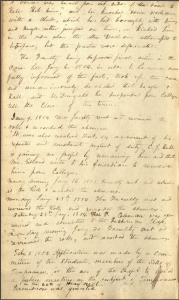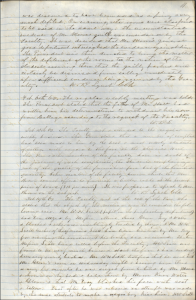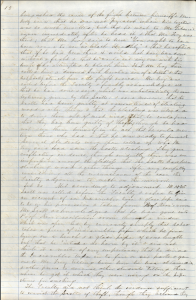The archives hold several bound volumes of minutes from the meetings of the trustees and faculty of Davidson College. The trustees met at irregular intervals throughout the nineteenth century, beginning in 1836, as they discussed monetary issues, student deportment, lack of students, faculty turnover, and the strain imposed by Civil War drafting and rationing. The trustee meetings initially took place at local churches, with several of the trustees representing the various presbyteries that supported the nascent Davidson College.
Though Davidson College classes officially began in 1837, no faculty meeting minutes were kept until 1845. Members of the faculty met weekly between 1845 and 1921 and discussed issues similar to those of the trustees. In 1921, the meetings moved to monthly sessions, meaning there are significantly fewer volumes found for later years.
The first volume of Faculty Minutes for Davidson College also contains the minutes of the Trustees of the Western Carolina College between May 1821 and June 1824. The North Carolina General Assembly authorized the establishment of a college in 1820, subsequently appointing trustees to oversee its development. These trustees met for three years, but were ultimately unable to raise sufficient funds for the effort—though this later gave way to the establishment of Davidson College.
The trustee and faculty minutes contain information about college assets, personal finances, student grades and conduct, curriculum development, and admissions policies. For this reason, minutes taken at these meetings typically have some restrictions to protect the privacy of those involved. Davidson’s trustee minutes have access restrictions for 75 years. There are no restrictions on nineteenth century faculty minutes. The Archives & Special Collections department is making a concerted effort to digitize these volumes, beginning with meetings that shed light on Davidson College’s relationship to and within the slave system, as well as systemic racial discrimination.
One of the most enlightening faculty minutes accounts dates to December 27, 1853, stating:
“The Faculty having heard that a fight had occurred on the 26th inst., at the lower store, between some of the students and some men from the country, proceeded to investigate the facts in the case. They found as follows:
That there was a wagon near the store, and several negroes, together with two young men by the name of Washam, near it. Two students, Robert A. H. Neagle and H.T. McDugald, in passing the wagon, accosted some of the negroes, telling them to take off their hates, and on their declining to do so, Neagle knocked off the hat of one of them; these two students then passed on into the store, where they met more negroes whom they accosted in the same way and McDugald, with a stick in his hand, knocked off the hat of one of them.
The two Washams followed them into the store and asked them if the store belonged to them, and repeated the question when, after some dispute and rough language between the parties, the students came back upon the College Hill to get help and several other students went down and among them, J.T. Kell, who, when he entered the store before the other, enquired for the man (or as some would have it, the negro) who would not take off his hat.
One of the Washams came out of the counting room, and replied to him. Neagle and McDugald came in after Kell, and after some words passing between the parties, one of the Washams hit Neagle and then a voice was heard from outside of the door to Kell – “hit him,” and he knocked down Washam with a club which he had brought with him, and Neagle either jumped on him or kicked him in the side, when the other Washam attempted to interfere, but the parties were separated.”
The three named students responsible for the degrading altercation were suspended from the college by the faculty for the remainder of the term the following month.

Davidson College faculty minutes from December 27, 1853.

Davidson College faculty minutes from December 27, 1853, continued.
There were also several recorded instances of blackface during the Civil War period. One of these instances was discussed by the faculty on February 19, 1863:
“Mr. W.H. Scott (pupil in the preparatory department) had been seized by Messrs. Moore, Knox, Glover, Troy, and Watts, and blacked and otherwise insultingly treated by them, and Mr. H.W. Scott, brother of the aforesaid Scott, had been beaten by Mr. Troy for resenting the treatment that his brother had received.
The two messrs. Scott being called before the Faculty, H.W. Scott was found to be very much bruised about the face, and had evidently been very seriously beaten. Mr. W.H. Scott testified that he went into Mr. Glover’s room on Wednesday night, and having been there a very few minutes, he was seized from behind by Mr. Moore and thrown on the bed and held there by Moore, Knox, Watts, and Glover, and that Mr. Troy blacked his face with soot and tallow. That after he was released, an attempt was made by the same students to make a negro boy kiss him.
H.W. Scott, being asked the cause of the fight between himself and Mr. Troy, said that he was not present when his brother was so much insulted, but that he went to Mr. Gibson’s room immediately after he heard it, and that Mr. Troy was there’ that Mr. Troy said to him “You ought to have been around to see us black Heathly,” and that he replied that if he had been there it would not have been done without a fight, and that we would cut anyone with his knife who attempted to black him. That Mr. Troy then called him a “damned South Carolina son of a bitch,” and that he (Scott) struck him, and the fight ensued.
Mr. Troy was called before the Faculty and frankly acknowledged all that he had done and said, which was substantially the same testimony given by the Scotts; and said moreover, that the Scotts had been guilty at various times of stealing wood and other things, and that the blacking was intended to drive them out of the West Wing. That he could prove that they had been guilty of theft, though he had not seen them himself in the act, that could mention those who had, and that he was ready to prove it.”

Davidson College faculty minutes from February 19, 1863.

Davidson College faculty minutes from February 19, 1863, continued.
In this case, the students were not initially suspended or expelled from the college for their behavior, but they were publicly admonished. Nearly one month later, on March 10, 1863, the faculty voted on a proposition to make “any student who disguises himself by blacking his face, altering his dress, or by any other means, guilty of a serious offence liable to immediate dismission from College.”
Although these striking accounts occasionally seem vague, we can learn a lot from what language is used, from what information is left out, and comparing these accounts to other records left from the period in question. Making these primary sources publicly available allows researchers to make those comparisons and bring often untold stories to light, while also revealing the historical roots of modern discrimination.

Speak Your Mind